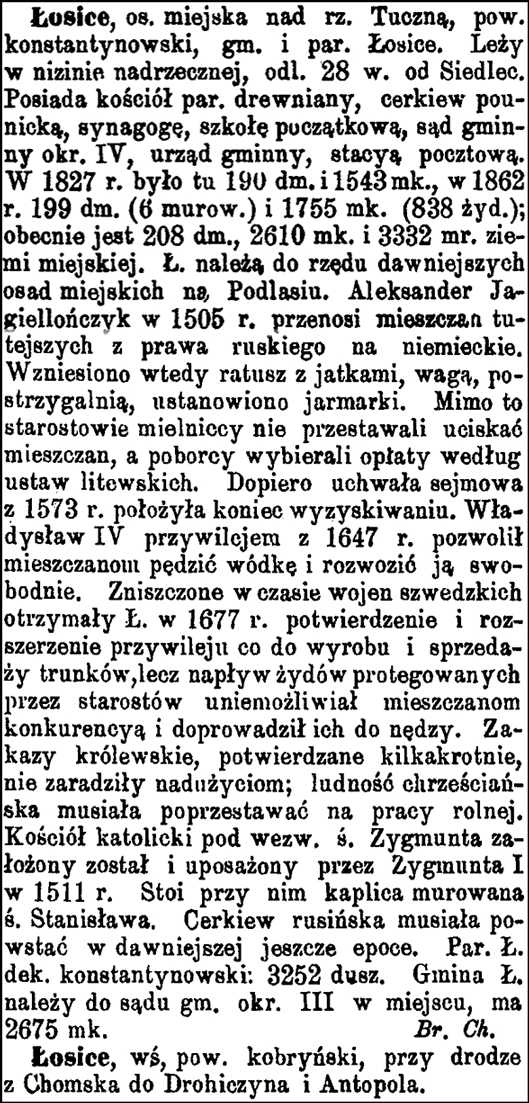One of the readers of this blog wrote to me and asked if there was an entry in the Słownik Geograficny Królestwa Polskiego (Geographical Dictionary of the Kingdom of Poland) for the Polish village of Łosice . There are, in fact, two entries for Łosice, one in the Konstantynów Powiat and the other in the Kobryń Powiat.
The Słownik Entry for Łosice
Click on the link for a PDF copy of the Słownik entry for Łosice . Translated from the Polish, the entry reads:
Łosice, an urban settlement on the Tuczna River in the Konstantynów Powiat [District], gmina [municipality] and parish of Łosice . It lies in the riverside lowlands, 28 versts [1 verst = 1.0668 kilometers] not far from Siedlce . It possesses a wooden parish church, a Uniate Orthodox church, a synagogue, an elementary school, a local court for the 4th district, and a post office . In 1827 there were 190 homes and 1543 residents here, in 1862 there were 199 homes (6 made of stone) and 1755 residents (838 Jews); currently there are 208 homes, 2610 residents, and 3332 mórgs [1 mórg in the Russian Partition = 1.388 acres] of urban land . Łosice belongs to the oldest ruling urban settlement in Podlasa . In the year 1505, Aleksander Jagiełło moved the local townspeople from Russian Law to German Law . At that time a town hall with a butcher’s shop, scales, a shearing room were erected, and a fair was set up . Despite this, the district governor of the place did not stop oppressing the townfolk, and his collectors collected fees according to Lithuanian laws . Not until the resolution of the Sejm [the Polish parliament] in the year 1573 was the exploitation ended . Władysław the fourth, with the charter in the year 1647, allowed the townspeople to distill vodka and to distribute it freely . Destroyed at the time of the Swedish War, in the year 1677 Łosice was granted confirmation and expansion of the charter for the establishment and sales of alcoholic beverages, but the arrival of the Jews, the protégés of the district governors, prohibited the competition of the townspeople and led them into extreme poverty . The royal ban, confirmed several times, did not rectify the abuse; the Christian population had to shift to agricultural labor . In the year 1511, the Catholic Church of Saint Zygmunt was founded and paid for by Zygmunt the first . The stone chapel of Saint Stanisław stood near it . A Russian Orthodox Church was established in an even earlier time . The Łosice parish of the Konstantynów deaconry had 3252 souls . The Gmina of Łosice belongs to the district court of the 3rd district, there were 2675 residents in that place.
Bronisław ChlebowskiŁosice, a village in the Kobryń Powiat [District], near the road from Chomsk to Drohiczyn and Antopol.
SOURCE: Sulimierski Filip, Bronisaw Chlebowski, and Władysław Walewski, eds., Słownik Geograficzny Królestwa Polskiego i Innych Krajów Słowiańskich (Geographical Dictionary of the Kingdom of Poland and other Slavonic Countries) – Warsaw 1884, Volume V, page 732.





You wrote “The royal ban, confirmed several times, did not rectify the abuse; the Christian population had to shift to agricultural labor.” What is the abuse exactly? Why did the Christian population suffer as a result of Jewish commercial activity? You also wrote “the arrival of the Jews, the protégés of the district governors, prohibited the competition of the townspeople and led them into extreme poverty.” Here and again, there is an attribution to jews and the suffering of christians. Weren’t the district governors also christians? Who is to blame in this instance?